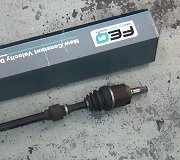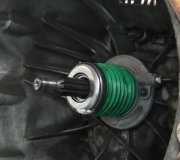I'm hoping there's more to the story besides just the outer joint. Was the entire half shaft replaced, and was it a used or rebuilt assembly? Was any other work done? In particular, anything with the engine mounts that may have repositioned the engine to one side a little?
The common symptoms with an elusive solution has to do with the inner CV joint housing. More often the shaking occurs at lower speeds, around 30 - 40 mph, but only under the load of acceleration. You won't have this problem with a new half shaft, but it can occur with a used or a rebuilt one. I don't know why, but this almost always happens to the right half shaft. I've had about a dozen of those, and only one on the left side. The shaking is felt in the steering wheel.
Tires are not a good suspect if this just started right after he half shaft was replaced. If your mechanic is confident this IS a tire issue, a far better suspect would be some debris cracked off the back of the wheel, due to normal corrosion, then got caught between the wheel and brake rotor when the wheel was reinstalled in a different orientation. That can be identified by using a dial indicator to measure the wheel's "lateral runout". In other words, the wheel is wobbling left and right as it goes around. If you have enough of that runout to see by eye, it's really bad. Most often you need the dial indicator to see it. That can be caused by a bent wheel, but given the recent service, debris caught behind the wheel is more likely.
It is not usually necessary to remove a brake caliper or rotor to remove the half shaft, but doing so can make the job easier on many import models. That presents an opportunity for scale, rust, or other debris to fall down behind the rotor's mounting surface. That will cause the rotor to wobble, and since the wheel rests against it, it will wobble too. In this case you're likely to feel the shaking in the brake pedal too. That shaking will be transmitted to the steering linkage and steering wheel, but the shaking there will be less severe than when it's caused by an inner CV joint.
The problem with debris between the wheel and rotor or rotor and hub is the vibration will not be affected by acceleration or coasting. It will be there all the time. When driving very slowly, as through a parking lot, you'll see the steering wheel oscillate back and forth a little, once per wheel revolution. If it's really bad, you may see one corner of the car move up and down a little with each wheel revolution. When you can see that, the vibration is usually too harsh to let you drive at highway speed without shaking your eyeballs loose.
Saturday, November 4th, 2023 AT 9:25 PM





